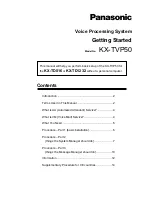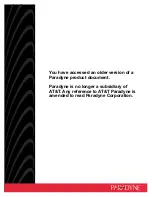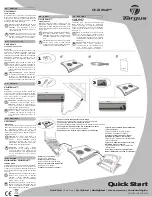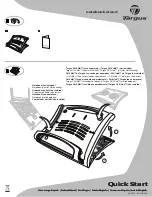
Alarm.com Image Sensor
Installation Guide
3 Copyright © 2015 Alarm.com. All rights reserved.
Rev 2.2
Figure 4. Removing Sensor for Battery Replacement
*The operation of the sensor with alkaline batteries has not been verified for
compliance with UL standards.
OTHER FEATURE COMPATIBILITY
Two-Way Voice Compatibility
Images cannot be transmitted while a Two-Way Voice call is in session. When the Image
Sensor is installed on a system with Two-Way Voice over the cellular network, image
transmission during an alarm may be interrupted by the two-way session. Image trans-
mission resumes once the call has terminated.
TS1 Compatibility
The Image Sensor uses the same RF radio (XCVR2) as the 2GIG TS1 touchscreen. Both
the Image Sensor and TS1 may be used on the same system using the same radio.
TROUBLESHOOTING
Sensor Not Enrolling
Verify Sensor is Receiving Power:
After inserting batteries, the sensor LED should
illuminate or flash within 10 seconds.
Verify Sensor is Not Communicating with Another Network:
The sensor must be deleted
from the system first through the control panel or remote command. If the sensor has
been previously enrolled in a different system, delete the sensor from the system.
Power down the panel the Image Sensor was previously enrolled in and hold the
sensor reset button for at least 10 seconds, until the LED flashes rapidly. This will reset
the sensor and place it in learn mode.
Sensor Non-Responsive
Replace Batteries
: Check battery level at the panel (under “Image Sensor” in the
“installer toolbox”) and install fresh sensor batteries.
False Motion Activations
Check Environmental Elements:
Heating or cooling elements may adversely affect
sensor performance. Test sensor with and without these elements to determine
interference.
Check Sensor Positioning:
The sensor may not be properly positioned to capture the
desired motion. Check horizontal positioning of sensor and re-mount as necessary.
Check PIR Sensitivity Setting:
Verify that the proper sensor motion profile has been
selected through the setup menu or select a less sensitive profile.
Sensor Tamper
The sensor detects changes in sensor orientation and can register a tamper regardless
of the sensor-back being removed. A tamper automatically clears after the sensor has
been returned to the upright position and has not detected any tamper activity for 5
minutes. With the sensor mounted, the tamper may also be cleared by holding the
sensor reset button for 3 seconds to initiate a power cycle.
Images Not Captured
Check Service Plan
: Make sure the account has the proper Image Sensor add-on.
Images cannot be captured without an Image Sensor service plan. For alarm
functionality, add the “Image Sensor Alarms” plan. For alarms and enhanced
functionality, add the “Image Sensor Plus” plan.
Verify Sensor Rules:
Make sure the sensor initialization process has been completed.
On the Dealer Website, make sure that the sensor rules have been confirmed using the
“Rules Confirmed” column.
Enable Auto Uploads:
During the first four hours after any sensor is enrolled onto the
system, alarm images are not automatically uploaded to Alarm.com. Automatic
uploads are automatically enabled after four hours. Enable uploads sooner from the
Dealer Website. On the Image Sensor Plus plan, view and request captured images
from any test alarms from the Customer Website.If the camera LED is blinking, refer to
this chart for LED trouble diagnostics.
Image Sensor Red Status LED Activity Reference
Device Status
or Error
LED
Pattern
Duration of LED Pattern
Sensor Power-
Up
Solid for 5
Seconds
Approximately first 5 seconds after powering.
Sensor Joins or
Rejoins Network
Solid for 5
Seconds
First 5 seconds after sensor joins a new network
(during enroll process) or rejoins its existing
network.
Searching for
Network to Join
Fast Blink
for 5
Seconds at
a Time
Repeats pattern for up to 60 seconds after powering
until the sensor enrolls in a network.
Attempting to
Rejoin Network
Slow Blink
for 5
Seconds at
a Time
Repeats pattern for up to 60 seconds after power
cycle until the sensor reconnects to its network.
(Note: This means the sensor has already been
enrolled into a network and is trying to connect to it.
If attempting to enroll sensor in a new network, hold
reset button for at least 10 seconds (until LED blinks
rapidly for at least two seconds) to clear the old
network before adding to new network.)
Motion Test
Mode
Solid for 3
Seconds at
a Time
Repeats for each motion activation during the 3
minutes after sensor joins network, has been
tampered, or is placed in PIR test mode. (Note: In
test mode, there is an 8 second “sleep” timeout
between motion trips.)
Network
Communication
Problem
Fast Blink
for 1
Second at
a Time
Pattern begins after 60 seconds of searching for (and
unsuccessfully joining) a network and repeats until
RF communication is restored. Pattern persists as
long as the sensor is not enrolled in a network or
cannot connect to current network.
TECHNICAL SPECIFICATIONS
Alarm.com Model Number
:
ADC-IS-220-GC
2GIG Part Number
: 2GIG-IMAGE1
Power Source
:
Optimal: 2 AA 1.5v Energizer Ultimate Lithium Batteries. Acceptable: 2 AA
1.5v alkaline batteries (battery life may be reduced significantly).
Expected Battery Life
:
Approximately 2 years for lithium batteries. Battery life varies by
use case depending on certain factors such as frequency of motion activations, image
captures, and IR flashes.
Voltage Thresholds
:
With lithium batteries, low battery alerts are issued at 3.05V. The
sensor cannot operate when the voltage reads below 2.3V.
Operating Temperature Range
:
32° to 110°F for non-pet applications, 60° to 110°F for
pet applications. Alkaline batteries are not suitable for temperatures below 50° F.
Weight
:
3.1 oz. (with batteries, without mounting accessories)
Dimensions
:
3.1’’ h x 1.8’’ w x 2.3’’ d
Supervisory Interval
:
1 hour
Color
:
White
Recommended Mounting Height
:
8 ft
Recommended Mounting Angle
:
6° for large coverage area and rooms greater than 30 ft
(“teeth up” on mounting arm); 18° for rooms less than 30 ft (“teeth down” on mounting arm)
Motion Profiles & Sensor Range
:
Normal (up to 30 ft, default), High (up to 35 ft), Low (up
to 25 ft)
REGULATORY INFORMATION
Changes or modifications not expressly approved by Alarm.com can void the user’s
authority to operate the equipment.
This device complies with Industry Canada license-exempt RSS standard(s). Operation is
subject to the following two conditions: (1) this device may not cause interference, and (2)
this device must accept any interference, including interference that may cause undesired
operation of the device.
Le présent appareil est conforme aux CNR d'Industrie Canada applicables aux appareils
radio exempts de licence. L'exploitation est autorisée aux deux conditions suivantes : (1)
l'appareil ne doit pas produire de brouillage, et (2) l'utilisateur de l'appareil doit accepter
tout brouillage radioélectrique subi, même si le brouillage est susceptible d'en
compromettre le fonctionnement.
This device complies with Part 15 of the FCC Rules. Operation is subject to the following
conditions.
1. This device may not cause harmful interference, and
2. This device must accept any interference received, including interference that may
cause undesired operation.
FCC ID: YL6-143220ISGC IC: 9111A-143220ISGC
Document 2GV21
Rev 2.1 040214






















